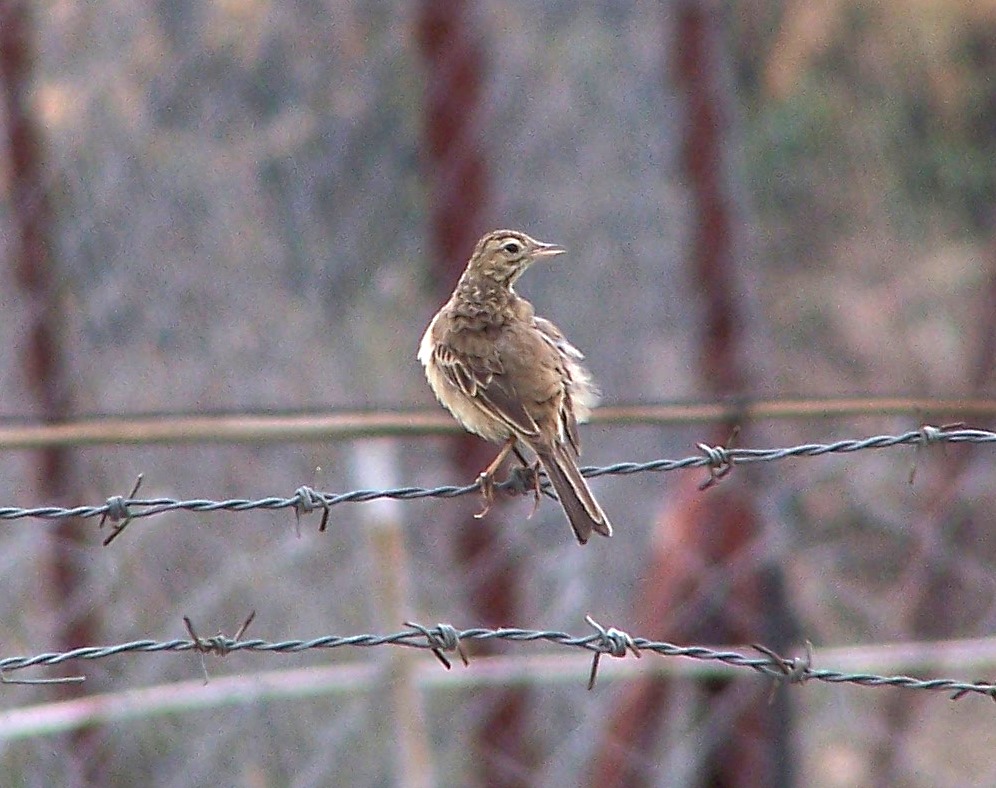- Richard's Pipit
Taxobox
name = Richard's Pipit
status = LC | status_system = IUCN3.1

image_caption = Richard's Pipit inHong Kong .
regnum =Animal ia
phylum = Chordata
classis =Aves
ordo =Passeriformes
familia =Motacillidae
genus = "Anthus "
species = "A. richardi"
binomial = "Anthus richardi"
binomial_authority = Vieillot, 1818The Richard's Pipit ("Anthus richardi") is a medium-sizedpasserine bird which breeds in open grasslands in northernAsia . It is a long-distance migrant moving to open lowlands in southernAsia . It is a rare but regular vagrant to western Europe. This bird was named after the French naturalist Monsieur Richard ofLunéville .It belongs to the
pipit genus "Anthus" in the familyMotacillidae . It was formerly lumped together with the Australasian, African, Mountain andPaddyfield Pipit s in a single species: Richard's Pipit, "Anthus novaeseelandiae". These pipits are now commonly considered to be separate species although the African and Paddyfield Pipits are sometimes treated as part of "Anthus richardi".Description
This is a large
pipit , 17-20 cm in length, with a weight of 25-36 g and a wingspan of 29 to 33 cm. It is a slender bird which often stands very upright. It has long yellow-brown legs, a long tail with white outer-feathers and a long dark bill with a yellowish base to the lower mandible. The hindclaw is long and fairly straight. It is an undistinguished-looking species on the ground, mainly brown above and pale below. There are dark streaks on the upperparts and breast while the belly and flanks are plain. The face is strongly marked with pale lores andsupercilium and dark eyestripe, moustachial stripe and malar stripe. There are two wingbars formed by pale tips to the wing-coverts.There is some variation between the different
subspecies . "A. r. sinensis" is slightly smaller than the nominate race with less streaking above. "A. r. centralasiae" is larger with more sand-coloured upperparts. "A. r. dauricus" has more streaking above.Its flight is strong and undulating, and it gives a characteristic explosive "shreep" call, somewhat similar to the chirp of a
House Sparrow . The song is a repeated series of monotonous buzzy notes given in an undulating song-flight.Some care must be taken to distinguish this from other large pipits which winter or are resident in the area, such as
Blyth's Pipit and Paddyfield Pipit. Blyth's Pipit has a shorter bill, legs and tail, a shorter and more curved hindclaw, less white on the tail and more streaking on the upperparts. In adult birds, the median wing-coverts have blunt-ended dark centres whereas in Richard's Pipit the dark centres become pointed towards the tip of the feather. The call of Blyth's Pipit call is quieter and less harsh. Paddyfield Pipit is smaller than Richard's Pipit with a shorter bill and tail, less streaking on the breast and a quieter call.Distribution
Richard's Pipit breeds in southern
Siberia ,Mongolia , parts ofCentral Asia and in northern, central and easternChina . It migrates south to winter in theIndian subcontinent ,South-east Asia and southern China with records as far south asSri Lanka ,Singapore and northernBorneo . It is a scarce passage migrant inKorea andJapan .A small part of the population regularly moves west in autumn and birds have been recorded from most countries in
Europe , theMiddle East andNorth Africa . It is seen annually between September and November at coastal watchpoints in areas such as Britain, theNetherlands andScandinavia with occasional birds appearing in spring. A few overwinter in countries likeSpain ,Portugal andMorocco .Ecology
It is a bird of open country, particularly flat lowland areas. It inhabits
grassland ,steppe and cultivated land, preferring more fertile, moist habitats. In Europe it is most often recorded on headlands and islands. It occurs alone or in small groups.Like other pipits, this species is insectivorous. It mainly feeds on the ground and will also make short flights to catch flying insects. A few
seed s are also eaten.The nest is made of
grass ormoss and is built on the ground under a grass tussock.References
* Database entry includes justification for why this species is of least concern.
* Harris, Alan; Tucker, Laurel & Vinicombe, Keith (1994) "TheMacmillan Field Guide to Bird Identification ", Macmillan Press.
* Lewington, Ian; Alström, Per & Colston, Peter (1991) "A Field Guide to the Rare Birds of Britain and Europe", HarperCollins.
* MacKinnon, John & Phillipps, Karen (2000) "A Field Guide to the Birds of China", Oxford University Press, Oxford.
* Robson, Craig (2002) "A Field Guide to the Birds of South-East Asia", New Holland, London.
* Simms, Eric (1992) "British Larks, Pipits and Wagtails", HarperCollins.
* Skerrett, Adrian; Bullock, Ian & Disley, Tony (2001) "Birds of Seychelles", Christopher Helm, London.
* Snow, D. W. & Perrins, C. M. (1998) "Birds of the Western Palearctic: Concise Edition", Vol. 2, Oxford University Press, Oxford.
Wikimedia Foundation. 2010.
